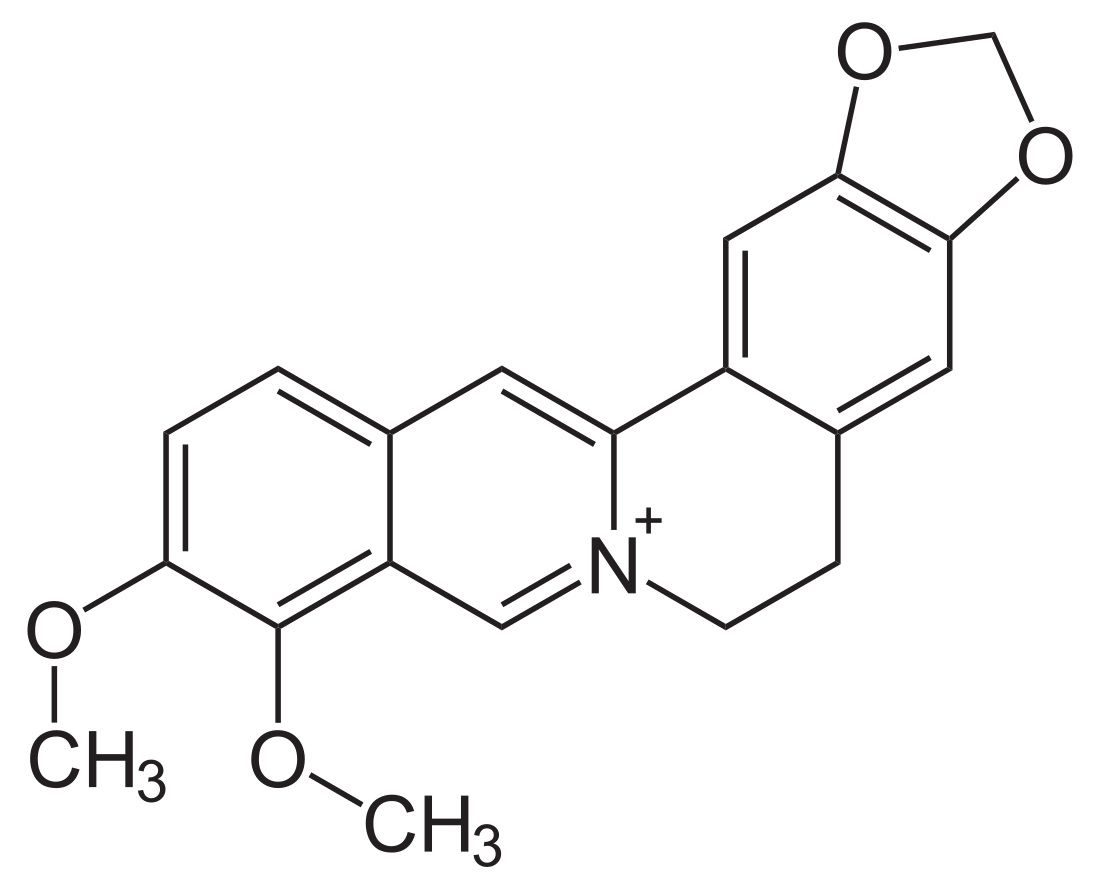Top Qs
Timeline
Chat
Perspective
Berberine
Quaternary ammonium cation From Wikipedia, the free encyclopedia
Remove ads
Berberine is a quaternary ammonium salt from the protoberberine group of benzylisoquinoline alkaloids, occurring naturally as a secondary metabolite in some plants including species of Berberis, from which its name is derived.
Due to their yellow pigmentation, raw Berberis materials were once commonly used to dye wool, leather, and wood.[4] Under ultraviolet light, berberine shows a strong yellow fluorescence,[5] making it useful in histology for staining heparin in mast cells.[6] As a natural dye, berberine has a color index of 75160.
Remove ads
Biological sources
The following plants are biological sources of berberine:
- Berberis vulgaris (barberry)
- Berberis aristata (tree turmeric)
- Berberis thunbergii
- Fibraurea tinctoria
- Mahonia aquifolium (Oregon grape)
- Hydrastis canadensis (goldenseal)
- Xanthorhiza simplicissima (yellowroot)
- Phellodendron amurense (Amur cork tree)[7]
- Coptis chinensis (Chinese goldthread)
- Tinospora cordifolia
- Argemone mexicana (prickly poppy)
- Eschscholzia californica (California poppy)
Berberine is usually found in the roots, rhizomes, stems, and bark.[8]
Remove ads
Biosynthesis
This section may be too technical for most readers to understand. (February 2025) |

The alkaloid berberine has a tetracyclic skeleton derived from a benzyltetrahydroisoquinoline system with the incorporation of an extra carbon atom as a bridge. Formation of the berberine bridge is rationalized as an oxidative process in which the N-methyl group, supplied by S-adenosyl methionine (SAM), is oxidized to an iminium ion, and a cyclization to the aromatic ring occurs by virtue of the phenolic group.[9]
Reticuline is the immediate precursor of protoberberine alkaloids in plants.[10] Berberine is an alkaloid derived from tyrosine. L-DOPA and 4-hydroxypyruvic acid both come from L-tyrosine. Although two tyrosine molecules are used in the biosynthetic pathway, only the phenethylamine fragment of the tetrahydroisoquinoline ring system is formed via DOPA[definition needed]; the remaining carbon atoms come from tyrosine via 4-hydroxyphenylacetaldehyde.[11]
Remove ads
Research
Studies on the pharmacological effects of berberine, including medical uses, are preliminary: some studies consider cell cultures or animal models, whereas clinical trials investigating the use of berberine in humans are limited.[12]
A 2023 review concluded that berberine may improve lipid concentrations.[13] High-quality, large clinical studies would be required to properly evaluate the effectiveness and safety of berberine in various health conditions.[12]
Berberine supplements are widely available in the U.S. but have not been approved by the U.S. Food and Drug Administration (FDA) for any specific medical use. Studies linking berberine to health benefits are limited. The quality of berberine supplements can vary across brands. A 2017 study found that out of 15 different products sold in the U.S., only six contained at least 90% of the specified berberine quantity.[14][15]
Adverse effects
Longer-term human clinical trials have reported flatulence and diarrhea as common issues. The problem can be replicated in rats, with disruption of the gut microbiome to blame.[16]
Drug interactions
Berberine is known to inhibit the activity of CYP3A4, an important enzyme involved in drug metabolism and clearance of endogenous substances, including steroid hormones such as cortisol, progesterone and testosterone. Several studies have demonstrated that berberine can increase the concentrations of cyclosporine in renal transplant patients and midazolam in healthy adult volunteers, confirming its inhibitory effect on CYP3A4.[17][18][19]
Remove ads
Use in China
It is approved in China as an over-the-counter (OTC) drug for diarrhea treatment. The package insert claims efficacy against E. coli and Shigella spp.[20]
The Chinese package insert contraindicates berberine for people with hemolytic anemia and with glucose-6-phosphate dehydrogenase deficiency (G6PD deficiency). The insert also specifically precautions its use in children with G6PD deficiency because it can produce hemolytic anemia and jaundice.[20]
Remove ads
References
Wikiwand - on
Seamless Wikipedia browsing. On steroids.
Remove ads


